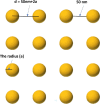Optimizing plasmonic photothermal therapy a numerical study on tissue specific thermal and optical properties for cancer treatment
- PMID: 40410282
- PMCID: PMC12102199
- DOI: 10.1038/s41598-025-95798-x
Optimizing plasmonic photothermal therapy a numerical study on tissue specific thermal and optical properties for cancer treatment
Abstract
Effective cancer treatment demands precision to target malignant tissues while sparing healthy ones. This study investigates numerically the role of plasmonic photothermal therapy (PPTT) as a minimally invasive approach to achieve this goal, focusing on the interplay between nanoparticle (NP) size, resonance wavelength, and the thermal properties of biological tissues. Tailoring NP characteristics to align with tissue-specific optical and thermal properties enables precise thermal delivery, enhancing therapeutic efficacy while minimizing collateral damage. Resonance wavelength shifts with NP size, while tissue parameters like thermal conductivity and refractive index further influence temperature profiles. These findings highlight the importance of optimizing PPTT protocols through computational modeling and experimental validation. This approach advances personalized cancer therapies, offering safer and more effective treatment outcomes.
© 2025. The Author(s).
Conflict of interest statement
Declarations. Competing interests: The authors declare no competing interests.
Figures






References
MeSH terms
LinkOut - more resources
Full Text Sources
Medical
Miscellaneous

